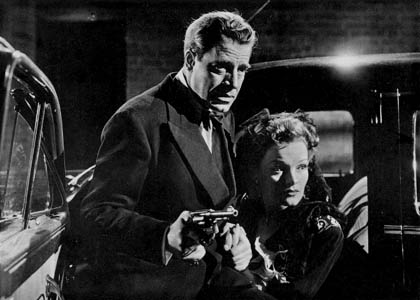« Colorado Dragon Film Festival 2018 | Main | Coffee Break »
March 08, 2018
No Orchids for Miss Blandish

St. John L. Clowes - 1948
KL Studio Classics BD Region A
There was a sense of familiarity when I read the excerpts from the reviews. "The most sickening exhibition of brutality, perversion, sex and sadism ever to be shown on a cinema screen." Another critic described Miss Blandish as "the worse film I've ever seen", while another called the film "this repellent piece of work". The reviews of that time are strikingly similar to the reviews of another British film that came out about twelve years later, Michael Powell's Peeping Tom. The kicker here is that there is another connection between these two films - Linden Travers stars in the title role as Miss Blandish, while her daughter, Susan Travers, appears as a model turned victim in Peeping Tom.
Seventy years later, this first film version from James Hadley Chase's novel doesn't seem so transgressive. The thugs here are almost genteel compared to the more obviously psychotic denizens in the novel or Robert Aldrich's remake, The Grissom Gang. There are moments, such as when a small time hood smashes a glass vase onto bartender Sid James' face would anticipate Mark Rydell's slamming the coke bottle on his girlfriend's face in Robert Altman's film of The Long Goodbye. Stateside, there was concern that a forty-five second kiss between Jack La Rue and Linden Travers was at least twenty-five seconds too long. The hero of the piece, investigator Dave Fenner, has a tendency to arrange would-be wardrobe malfunctions with a couple of the women who work at Ma Grisson's nightclub.
The film takes place in and near New York City, where many of the citizens speak with British accents. The actors playing gangsters appear to have studied Warner Brothers movies, or gone to the Bowery Boys School of Elocution. That actor who nearly blinds Sid James does a great impersonation of Leo Gorcey. Most of the film takes place either in Ma Grisson's cavernous nightclub, or in the offices and bedrooms conveniently located upstairs. The basic story is that the initial plan to steal jewels from the heiress of the millionaire "Meat King" turns into a kidnapping. Written before there was the term, "Stockholm Syndrome", Miss Blandish falls in love with Slim, the son of the gang leader.
Reportedly, St. John Clowes wanted Jane Russell as Miss Blandish, but cast Linden Travers, who starred in the 1942 stage production. Travers vaguely resembles Russell, but at age 35 was clearly too old to play the part of a bride-to-be, especially one whom Chase emphasized was a virgin. Jack La Rue, the only American actor in the cast, easily looked the part of the tough guy, although by the end of the film, he is turned into an ersatz Humphrey Bogart. Neither of the leads seem as psychologically unhinged as in Chase's novel or Aldrich's version. What protests Miss Blandish initially has about being kidnapped drift away here mostly because shacking up with Slim is a welcome change from the routines of high society.
There is virtually nothing written about St. John Clowes other than a list of his works as a writer and director. He died fairly young at age 44 in 1951. The story here is a bit padded out with nightclub musical numbers, a couple of dance duos, with a female vocalist as one of the characters. Even with his reputation mostly being literary, Clowes has his moments of visual virtue with relatively long takes of gang member in discussion, with the actors sometimes moving in and out of the frame, and the camera moving to keep them in the frame as needed for dramatic purposes. Maybe this is from originally working as a playwright, keeping dialogue heavy scenes from being static on stage, adding a visual panache on film. Even in a film that can easily be the subject of derision will there also be flashes of undeniable talent.
Posted by Peter Nellhaus at March 8, 2018 10:34 AM
